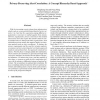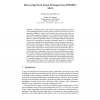86 search results - page 2 / 18 » Learning attack strategies from intrusion alerts |
COMCOM
2006
13 years 9 months ago
2006
To defend against multi-step intrusions in high-speed networks, efficient algorithms are needed to correlate isolated alerts into attack scenarios. Existing correlation methods us...
CN
2007
13 years 9 months ago
2007
Intrusion detection systems (IDS) often provide poor quality alerts, which are insufficient to support rapid identification of ongoing attacks or predict an intruder’s next lik...
ACSAC
2005
IEEE
14 years 3 months ago
2005
IEEE
With the increasing security threats from infrastructure attacks such as worms and distributed denial of service attacks, it is clear that the cooperation among different organiza...
DMIN
2006
13 years 10 months ago
2006
Since it is desirable for an intrusion detection system to be operated with the real time performance, it is not unusual for an intrusion detection engine to perform a "lazy ...
ESORICS
2004
Springer
14 years 2 months ago
2004
Springer
Abstract. Correlating security alerts and discovering attack strategies are important and challenging tasks for security analysts. Recently, there have been several proposed techni...


